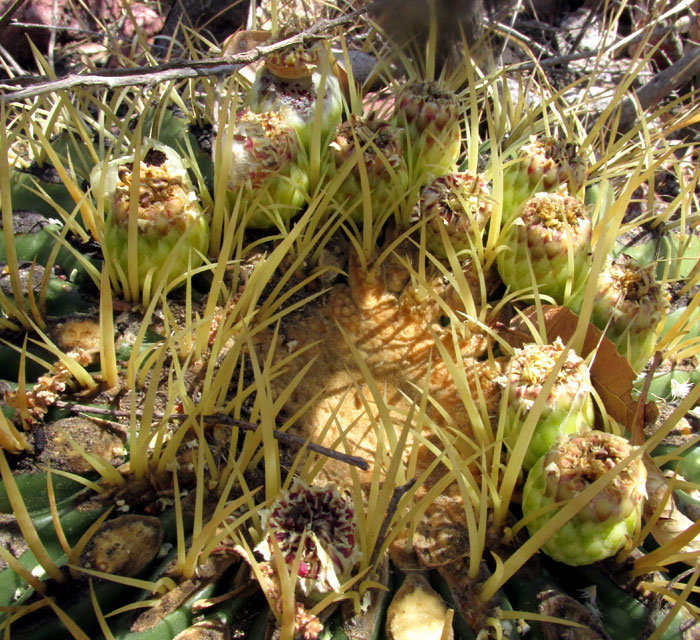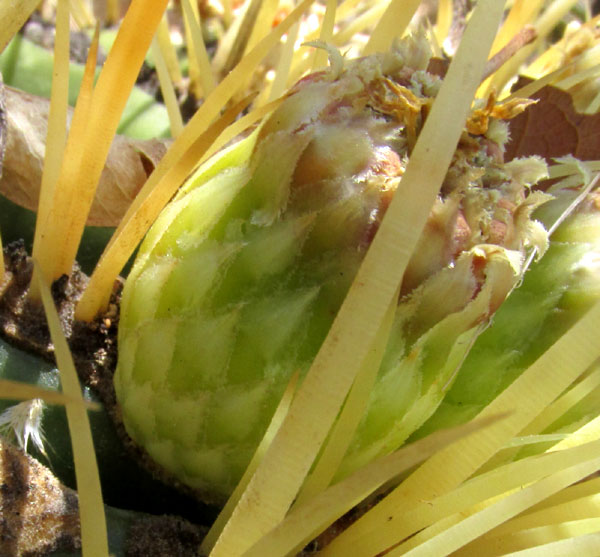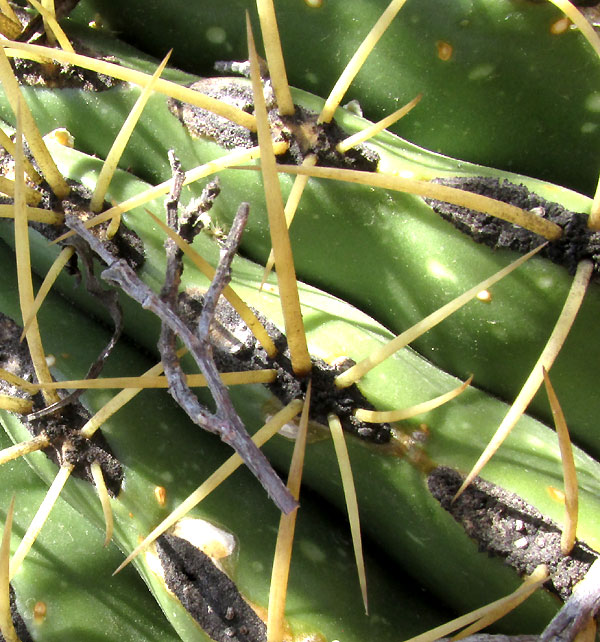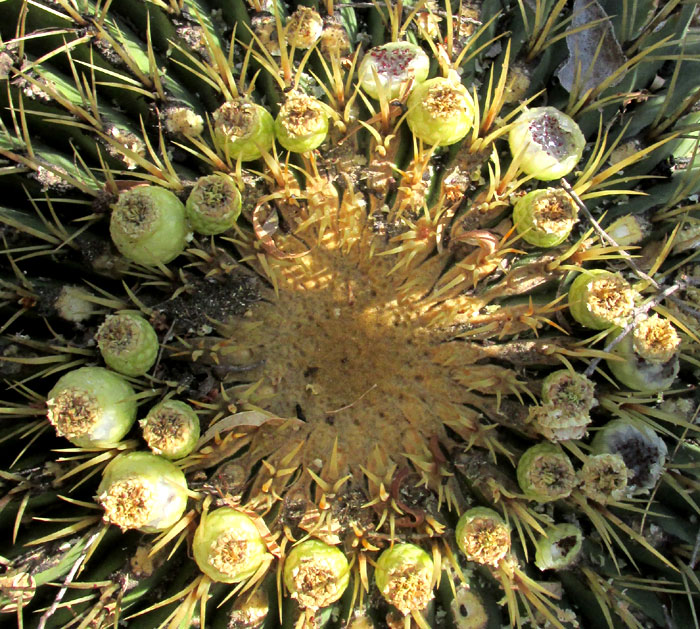Excerpts from Jim Conrad's
Naturalist Newsletter
entry dated May 18, 2022, notes from a camping trip among hills about 7kms ENE of Tequisquiapan, Querétaro state, MÉXICO
elevation about 2020m (6600 ft), near N20.57°, W99.85°
BARREL CACTUS FRUITING

Beneath a late-dry-season-leafless oak tree on a rocky, grassy slope, the above barrel-type cactus leaned toward the light. The rocks were mostly composed of volcanic rhyolite, and the cactus was about knee high and half a meter wide (18 inches). Atop the cactus was a ring of what appeared to be expanding ovaries (future fruits) of old flowers, or maybe immature fruits, shown below:

In cactus identification, an important field mark to notice is whether the ovaries and fruits bear spines. The picture below shows this species' spineless fruit;

And of course it's extremely important to note the nature and disposition of spines as they arise from their special spots, the areoles:

The rib-top areoles were narrow and close together but not touching. Six or seven cream-yellow spines arose from each areole, and the spines were mostly roundish in cross section, not flattened as in many species.
Already we had enough information to identify this handsome being, but later while wandering lower down the slope among mesquite thickets, a much larger individual turned up, well hidden by bushes, tall grasses and vines, which also were sheltering beneath the mesquite's low hanging, spiny branches, and on this cactus the fruits were more numerous, and larger:

The ribs seem more numerous, too. This one bore about 31. Later I read that the species can have up to 38. The first individual encountered had been a younger one with fewer ribs. I suspect that this big one survived only because it was so well hidden below the mesquite, for cactus robbers have been very busy scouring this whole area and have left many gaping holes.
Not only were these fruits ripe, but something had begun feeding on them:

I wanted to taste this succulent-looking fruit but among the very hard, stiff and quite sharp spines it was nearly impossible to insinuate two fingers. The mature fruits couldn't be pried out with a knife blade below it, and it was even very hard to cut the fruit's connection to the cactus body. This cactus wanted its fruits to be eaten just by creatures who could get at them, like small birds. During this trip I was feeding abundantly on Garambullo cactus fruits, and those ripe fruits fell off with a simple soft nudge. Every species has its own ideas about things.
With all the above features and more, the cacti easily keyed out to FEROCACTUS HISTRIX, which seems to have no English name specific to it, which I'm willing to perpetuate. The species is sold commercially on a large scale under such names as Candy-barrel Cactus, Electrode Cactus, and similar made-up cute names; and of course the locals call it Biznaga, as they do all the numerous barrel-type cacti regardless of appearance. Indigenous Americans have their own specific names for it, and one of those for this species is Guamishi.
Ferocactus histrix in its natural state is endemic just to about eight states in semiarid upland central Mexico, with Querétaro being somewhat in the east-center of its distribution.
Besides depredations by cactus thieves to sell to collectors and gardeners, the species' populations suffer from the usual habitat destruction, especially overgrazing with accompanying soil depletion, and the frequent intentional burning of such habitats "to encourage the growth of grass" for grazing livestock. This severely damages and kills cacti. Sometimes ranchers knock the various species of barrel cacti down and chop them up for cattle to eat. Traditionally people sometimes collected the fruits for making marmalades and other such sweetened dishes. I found the seedy pulp without much taste, but with sugar it would have been tasty enough.
Rafael F. del Castillo and Sonia Trujillo's 1991 publication "Ethnobotany of Ferocactus histrix and Echinocactus platyacanthus (Cactaceae) in the Semiarid Central Mexico: Past, Present and Future" tell us that this species in pre-Columbian times was regarded as sacred, used for sacrifices, food and medicine. They claim that as of 1991 it was being used in the candy industry, as medicine, as a source of food and water for goats and as ornamental plants; and that the flower buds and fruits were eaten by local people, the fruits being sold in local markets.